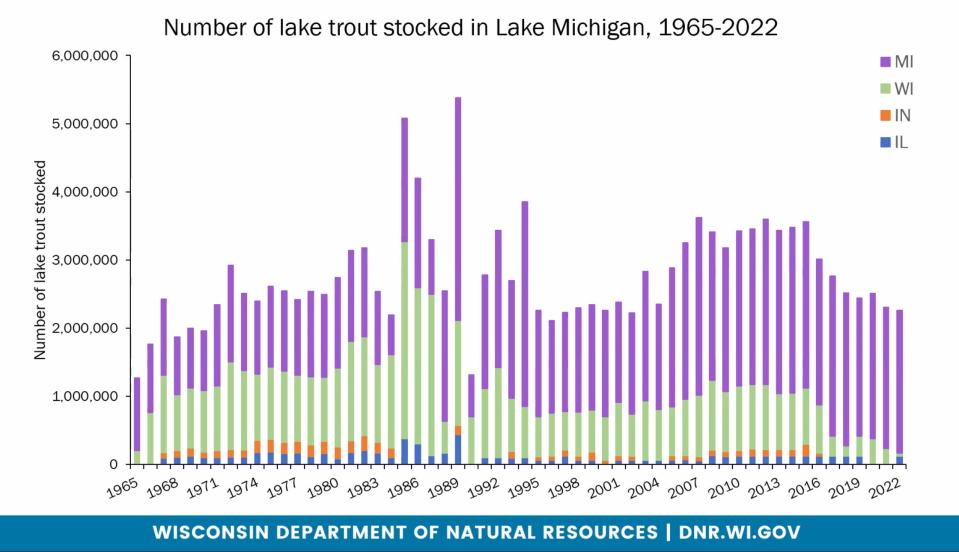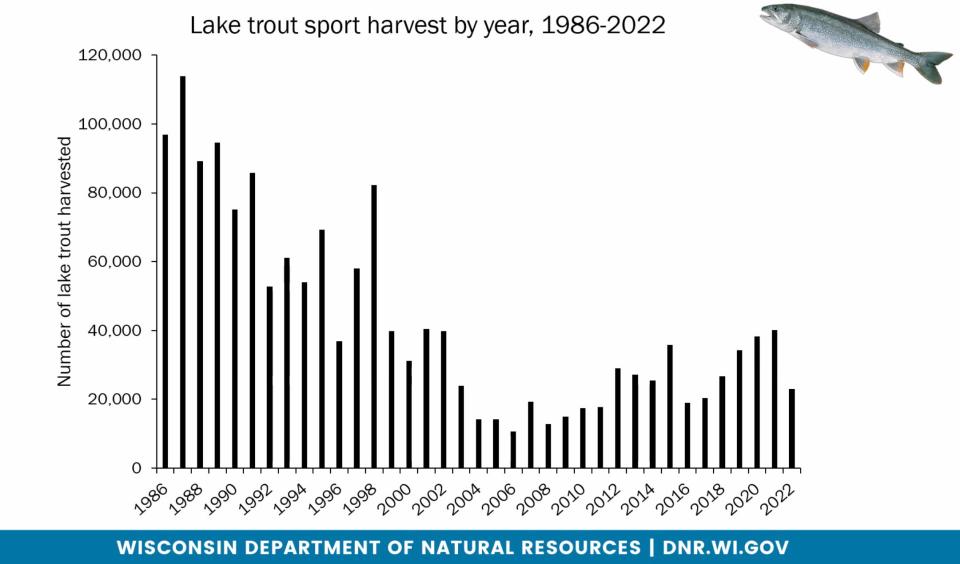Smith: Wisconsin DNR convenes group to study whether lake trout should be commercially netted on Lake Michigan
Among Wisconsin fish and wildlife in the 21st century, white-tailed deer and gray wolves arguably pose the greatest challenges for natural resources managers.
The difficulties are less biological than social and predominantly revolve around human factors.
An emerging issue will likely add a third native species - lake trout - to the top tier of complex, tough tasks for the Department of Natural Resources.
Last year the Lake Michigan Commercial Fishing Board made a formal request to begin netting lake trout on Lake Michigan.
The bid isn't meritless - lakers are faring well in Lake Michigan, showing decent evidence of natural reproduction and sport anglers are taking less than half of the established annual safe harvest. In addition, Wisconsin allows commercial fishing for the species in Lake Superior.
"It's absolutely time (for a commercial lake trout rule to be implemented)," said Charlie Henriksen, a commercial fisherman from Sturgeon Bay and chairman of the commercial fishing board. "I mean there's just no reason that this isn't happening."
But it would go against decades of fishing history in Lake Michigan and come before a long-term lake trout rehabilitation project is deemed complete.
Bob Wincek, president of the Wisconsin Federation of Great Lakes Sport Fishing Clubs, said his group was opposed to commercial fishing for lake trout in Lake Michigan "until it can be proven by DNR and U.S. Fish and Wildlife Service that it can be viable to allow a small, commercial harvest."
The DNR hasn't decided whether to start the process to change an administrative rule and allow commercial netting of lakers on Lake Michigan.
DNR forms Lake Michigan Lake Trout Commercial Harvest Stakeholder Group
But it has decided on a process to examine the issue.
To that end the DNR formed the Lake Michigan Lake Trout Commercial Harvest Stakeholder Group, about a dozen state residents including commercial fishers, sport anglers, charter fishing captains, wholesale fish dealers and others interested in the fishery.
The group held its first meeting Tuesday night at Lakeshore Technical College in Cleveland and over Zoom. Three other gatherings are scheduled for the coming months.
The group is "charged with providing input to the DNR for consideration as it develops recommendations and final decisions on pursuing a statement of scope for commercial harvest of lake trout," according to the DNR.
Henriksen and Wincek are members of the group, as are: charter captain Lee Haasch of Algoma; commercial fishermen Dennis Hickey and Todd Stuth; Arnie Arredondo, president of the Wisconsin Lakeshore Business Association; fish wholesaler Jamie LeClair; Michelle Lawrie of Door County Economic Development; John Anderson of the Kenosha Sportfishing and Conservation Association; Dale Maas of the Wisconsin Conservation Congress; Sharon Fegley Moen and Titus Seilheimer of Wisconsin Sea Grant; and Jerry Fetterer of Sheboygan Great Lakes Sportfishing Club.
Meeting examines Lake Michigan lake trout assessments
Tuesday's meeting focused on Lake Michigan lake trout assessments and a presentation by Laura Schmidt, the DNR's Lake Michigan lake trout biologist.
The gathering was moderated by Jean Romback-Bartels, DNR secretary's director for northeastern Wisconsin.

Commercial fishers historically caught lake trout in Lake Michigan and enjoyed a stable fishery until about 1945 when it declined substantially. The primary culprit was the sea lamprey, a parasitic aquatic invasive species which devastated lake trout and burbot populations in the lake.
But lake trout numbers began to recover thanks to protective regulations, an intensive lamprey control program, and intensive lake trout stocking conducted by the U.S. Fish and Wildlife Service.
The USFWS has a goal of rehabilitating lake trout in the lake expressed as: "Re-establish in targeted high-priority areas and refuges of Lake Michigan a diversity of primarily lean lake trout populations predominately supported by natural reproduction that provide sustainable yields to recreational, commercial, and subsistence fisheries."
About 2.25 million lake trout are stocked annually in the lake.
Biologists determined 82,000 lake trout as the annual safe harvest. Yet sport anglers have taken an average of 29,027 per year over the last 10 years, Schmidt said.
Schmidt showed a variety of rehabilitation benchmarks, including from spring and fall surveys and ranging from "hits to misses." The conclusion was lake trout were "not yet self-sustaining in Lake Michigan."
Lake Michigan at this time only has commercial fishing for lake trout in a portion of Michigan waters. From 1969 to 2021 the sport harvest in Wisconsin waters of LM has been about 45,000 lake trout.

However, Henriksen and the commercial fishing board only want to harvest about 40,000 lake trout a year, a number that when coupled with the sport take would stay within the established safe harvest.
"I think it's now time for us to participate in this fishery," Henriksen said. "To reserve this fish strictly for sport fishing isn't right, it just isn't fair."
Mark LaBarbera, executive director of the Wisconsin Wildlife Federation, said his group sees it differently.
“Our Wildlife Federation members and affiliates who are most familiar with Great Lakes issues strongly oppose commercial fishing of lake trout in Lake Michigan and oppose spending time and money on a scoping statement," LaBarbera said. "They say, ‘What’s next? Other game fish?’"
Smith:Science weighs heavily in Wisconsin's successful sturgeon management
Smith:DNR increases Lake Michigan chinook stocking goal for 2023
LaBarbera said the WWF Great Lakes Committee will be bringing the issue up at its next meeting along with concerns about sportfishing money being used to monitor and deal with commercial fishing issues.
All meetings of the stakeholder group are open to the public and will be held at Lakeshore Technical College in Cleveland and via Zoom. Agendas and recordings of previous meetings will be posted to the DNR's website.
The group's three additional meetings are planned for: March 20, with a focus on lake trout mass marking work conducted by the USFWS; April 18, lake trout population and forecast models; and May 16, working group discussion and recommendations.
After the stakeholder group completes its work, DNR managers will review recommendations and comments and decide whether to proceed with a scope statement, the first step in developing a rule needed to allow commercial fishing for lake trout on Lake Michigan.
People can submit comments on the topic by email at DNRLAKEMICHIGANPLAN@wisconsin.gov.
Rule process typically takes 2-3 years
The administrative rule development process typically takes 2-3 years, start to finish, so even if approved any commercial take of lake trout wouldn't occur for several years.
Tuesday's meeting was the first step in illuminating facts, as well as what isn't well understood, about the status of lake trout in the Big Pond. It also highlighted how people view the resource differently and the challenges the group will face.
Romback-Bartels thanked the stakeholder group members at the end of the meeting.
"(Your participation) is extremely important to the DNR," Romback-Bartels said. "We take this very seriously. It's a treasure to the state of Wisconsin and we want to keep it as such."
Our subscribers make this reporting possible. Please consider supporting local journalism by subscribing to the Journal Sentinel at jsonline.com/deal.
DOWNLOAD THE APP: Get the latest news, sports and more
This article originally appeared on Milwaukee Journal Sentinel: Wisconsin DNR to study lake trout commercially netted Lake Michigan

